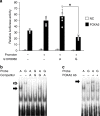Genome-wide association study identifies 14 previously unreported susceptibility loci for adolescent idiopathic scoliosis in Japanese
- PMID: 31417091
- PMCID: PMC6695451
- DOI: 10.1038/s41467-019-11596-w
Genome-wide association study identifies 14 previously unreported susceptibility loci for adolescent idiopathic scoliosis in Japanese
Abstract
Adolescent idiopathic scoliosis (AIS) is the most common pediatric spinal deformity. Several AIS susceptibility loci have been identified; however, they could explain only a small proportion of AIS heritability. To identify additional AIS susceptibility loci, we conduct a meta-analysis of the three genome-wide association studies consisting of 79,211 Japanese individuals. We identify 20 loci significantly associated with AIS, including 14 previously not reported loci. These loci explain 4.6% of the phenotypic variance of AIS. We find 21 cis-expression quantitative trait loci-associated genes in seven of the fourteen loci. By a female meta-analysis, we identify additional three significant loci. We also find significant genetic correlations of AIS with body mass index and uric acid. The cell-type specificity analyses show the significant heritability enrichment for AIS in multiple cell-type groups, suggesting the heterogeneity of etiology and pathogenesis of AIS. Our findings provide insights into etiology and pathogenesis of AIS.
Conflict of interest statement
The authors declare no competing interests.
Figures



Similar articles
-
Genome-wide association study identifies new susceptibility loci for adolescent idiopathic scoliosis in Chinese girls.Nat Commun. 2015 Sep 22;6:8355. doi: 10.1038/ncomms9355. Nat Commun. 2015. PMID: 26394188 Free PMC article.
-
A meta-analysis identifies adolescent idiopathic scoliosis association with LBX1 locus in multiple ethnic groups.J Med Genet. 2014 Jun;51(6):401-6. doi: 10.1136/jmedgenet-2013-102067. Epub 2014 Apr 10. J Med Genet. 2014. PMID: 24721834
-
Replication Study for the Association of GWAS-associated Loci With Adolescent Idiopathic Scoliosis Susceptibility and Curve Progression in a Chinese Population.Spine (Phila Pa 1976). 2019 Apr 1;44(7):464-471. doi: 10.1097/BRS.0000000000002866. Spine (Phila Pa 1976). 2019. PMID: 30234802
-
[Genome-wide association study for adolescent idiopathic scoliosis].Clin Calcium. 2016 Apr;26(4):553-60. Clin Calcium. 2016. PMID: 27013625 Review. Japanese.
-
The association of rs11190870 near LBX1 with the susceptibility and severity of AIS, a meta-analysis.Int J Surg. 2018 Jun;54(Pt A):193-200. doi: 10.1016/j.ijsu.2018.01.051. Epub 2018 Mar 10. Int J Surg. 2018. PMID: 29535018 Review.
Cited by
-
Resolving primary pathomechanisms driving idiopathic-like spinal curvature using a new katnb1 scoliosis model.iScience. 2022 Aug 28;25(9):105028. doi: 10.1016/j.isci.2022.105028. eCollection 2022 Sep 16. iScience. 2022. PMID: 36105588 Free PMC article.
-
Impaired glycine neurotransmission causes adolescent idiopathic scoliosis.J Clin Invest. 2024 Jan 16;134(2):e168783. doi: 10.1172/JCI168783. J Clin Invest. 2024. PMID: 37962965 Free PMC article.
-
The cartilage matrisome in adolescent idiopathic scoliosis.Bone Res. 2020 Mar 9;8:13. doi: 10.1038/s41413-020-0089-0. eCollection 2020. Bone Res. 2020. PMID: 32195011 Free PMC article. Review.
-
Evaluating significance of European-associated index SNPs in the East Asian population for 31 complex phenotypes.BMC Genomics. 2023 Jun 13;24(1):324. doi: 10.1186/s12864-023-09425-y. BMC Genomics. 2023. PMID: 37312035 Free PMC article.
-
EPHA4 signaling dysregulation links abnormal locomotion and the development of idiopathic scoliosis.Elife. 2025 Jul 15;13:RP95324. doi: 10.7554/eLife.95324. Elife. 2025. PMID: 40662934 Free PMC article.
References
-
- Kane, W. J. Scoliosis prevalence: a call for a statement of terms. Clin. Orthop. Relat. Res. 126, 43–46 (1977). - PubMed
-
- Moriyama T, et al. School screening for spine deformity, and epidemiological investigation for spina bifida occulta in Hanshin district (3rd reports). Shouni No Noushinkei (Nervous System in Children) 2011;36:542–544.
Publication types
MeSH terms
Substances
LinkOut - more resources
Full Text Sources
Medical

